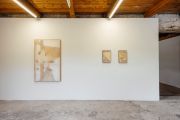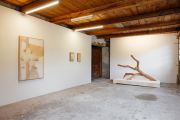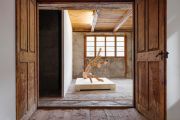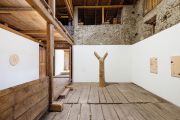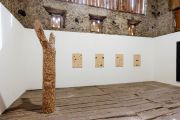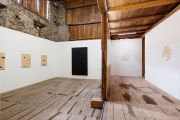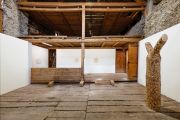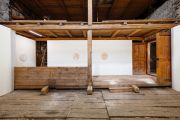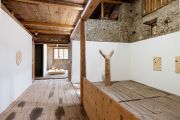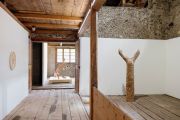Mirko Baselgia
structura / sistem
July 29 - September 3, 2023
Galerie Urs Meile Ardez
press Release - English
The exhibition Mirko Baselgia - structura / sistem - “structure / system” in Rhaeto-Romanic - brings together recent works by the artist that explore the diversity of meanings and manifestations of these two concepts. Observing, understanding and reshaping structures and systems, whether material or abstract, visible or hidden, that characterize the natural world and society, form a central aspect of Mirko Baselgia’s artistic practice. The in-depth study of organisms, materials, processes, and physical or conceptual architectures allow him to depict the diversity and complexity of our reality and to explore the mechanisms underlying the interdependencies and tensions between the various entities that inhabit the universe. In his artistic exploration, Baselgia questions his existence and the place he wants to occupy in the world, imagining new ways of living and interacting with all forms of life and the environment around us.
In the first room, our gaze is immediately caught by a wooden sculpture that welcomes us with its warm and lively presence. tailored skin for forked tree (2022, european walnut shingles on pine trunk, 242 x 88 x 44 cm), with its precious shell of walnut shingles, offers, like the other works on display, a reflection on the skin and its function both as protection and of communication between our body, our person, our interiority and the outside world. The skin in its various forms is one of the recurring themes in the artist’s work, and the origin of this interest lies in his biography. Since his birth, Mirko Baselgia has suffered from a hereditary skin disease called ichthyosis vulgaris, which leads to dry, scaly skin on one or more parts of the body. Ichthyosis vulgaris is often called fish scale disease - the prefix “ichthyo-” comes from ancient Greek and means “fish” - because the scales typical of the disease, resemble those of a fish. Baselgia’s shingles works are therefore also a reference to his own body and identity. The sculpture is
accompanied by three paintings with geometric compositions and subtle color palette that reflects the mineral richness of the Alpine landscapes. The artist uses pigments obtained from stones that he collects himself, together with a family friend, in the region around his studio. These colors bear witness to the geological events that have shaped and changed the area over the millennia. On a conceptual level, the combination of the pigments with the regional larch wood used for the stretcher bars, the linen of the
handmade canvases, and the beeswax of a local beekeeper used to cover the two small paintings can be seen as a reduction, an abstraction of a precise ecosystem.
Structures and systems are also reflected in the series of three plaster reliefs with mineral pigments - Antupada II - The Bee dreams up the Flower and the Flower dreams up the Bee (2022, 2/5, plaster, mineral pigments, Ø 55 cm, edition of 5 + 1 AP), Antupada III - Bee and Flower are together in a Way in which, if you take One out, Both of Them disappear (2022, 1/5, plaster, mineral pigments, Ø 55 cm, edition of 5 + 1 AP) and Antupada IV - Fragments of a Dreamlike Illusion (2022, 1/5, plaster, mineral pigments, Ø 55 cm, edition of 5 + 1 AP) - in the corridor of the second room are examined from an ecological but also formal point of view. These works highlight the strong interdependent relationships that connect all life forms to each other and to their environment.
The main area of the second room is entirely devoted to the material wood. The sculpture my grandmother’s father was a carpenter too (2022, apple tree wood shingles on apple tree trunk, 160 x 200 x 120 cm), the relief with shingles of burnt larch wood Big Black (2020, burnt larch wood panel, linseed oil, 220 x 136 x 5.5 cm) and the new series of wooden panels with more or less symmetrical compositions of burnt wooden circles puncts da conzentraziun (2023, stone pine wood and burnt stone pine wood, 77 x 55 x 2. 2 cm) touch on central themes and concerns in Baselgia’s work: his affection for wood, the recurring themes of skin and growth, his desire to make structures visible and to reflect on materiality and corporeality. The sculpture my grandmother’s father was a carpenter too is also a meditation on family structure and heritage and the way they shape our own lives. For the series puncts da conzentraziun, the artist follows the structure of the wood and works out circles in the places of the tree where the branches come from, which are burned and then reinserted into the panel. These points marked by the fire symbolize the concentration, the flow of energy necessary to give birth to new branches and leaves, so that they in turn can draw new energy from the sun. They also suggest an analogy with the energy centers of the human body, the collection and transformation points of our life energy. Wood has been part of the artist’s life since birth: for four generations, all the way back to his father, the craft of carpentry has been passed down in his family. In addition, his uncle and godfather were forest farmers. The smell of wood permeates his childhood memories and his whole life. The new series of wooden panels establishes a structural link between the body of the tree and the human body, pointing out that the functioning and history of any organism can be felt and understood in its matter and structure.
Text: Laura Giudici
Press Release German
Die Ausstellung Mirko Baselgia - structura / sistem - “Struktur / System” auf Rätoromanisch - versammelt aktuelle Werke des Künstlers, welche die Vielfalt von Bedeutungen und Erscheinungsformen dieser beiden Begriffe erkunden. Die Beobachtung, das Verständnis und die Neugestaltung von Strukturen und Systemen, ob materiell oder abstrakt, sichtbar oder verborgen, welche die natürliche Welt und die Gesellschaft charakterisieren, bilden einen zentralen Aspekt der künstlerischen Praxis von Mirko Baselgia. Die eingehende Untersuchung von Organismen, Materialien, Prozessen und physischen oder konzeptionellen Architekturen ermöglichen es ihm, die Vielfalt und Komplexität unserer Realität darzustellen und die Mechanismen zu ergründen, die den gegenseitigen Abhängigkeiten und Spannungen
zwischen den verschiedenen Entitäten, die das Universum bewohnen, zugrunde liegen. In seiner künstlerischen Auseinandersetzung stellt Baselgia seine Existenz und den Platz, den er in der Welt einnehmen möchte, in Frage und stellt sich neue Wege des Zusammenlebens und der Interaktion mit allen Formen des Lebens und der Umwelt um uns herum vor.
Im ersten Raum wird unser Blick sofort von einer Holzskulptur gefangen, die uns mit ihrer warmen und lebendigen Präsenz empfängt. tailored skin for forked tree (2022, Schindeln aus europäischem Nussbaum auf Kiefernstamm, 242 x 88 x 44 cm), mit ihrer kostbaren Hülle aus Walnussholzschindeln, bietet, wie auch die anderen ausgestellten Werke, eine Reflexion über die Haut und ihrer Funktion sowohl als Schutz als
auch der Kommunikation zwischen unserem Körper, unserer Person, unserer Innerlichkeit und der Aussenwelt. Die Haut in ihren verschiedensten Formen ist eines der wiederkehrenden Themen im Werk
des Künstlers, und der Ursprung dieses Interesses liegt in seiner Biographie. Seit seiner Geburt leidet Mirko Baselgia an einer erblichen Hautkrankheit namens Ichthyosis vulgaris, die zu trockener, schuppiger Haut an einer oder mehreren Körperstellen führt. Ichthyosis vulgaris wird oft als Fischschuppenkrankheit bezeichnet - die Vorsilbe “ichthyo-” kommt aus dem Altgriechischen und bedeutet “Fisch”-, weil die für die Krankheit typischen Schuppen, denjenigen eines Fisches gleichen. Baselgias Gürtelrose-Arbeiten sind daher auch ein Verweis auf seinen eigenen Körper und seine Identität. Die Skulptur wird von drei Gemälden mit geometrischen Kompositionen und subtiler Farbpalette begleitet, die den mineralischen Reichtum der Alpenlandschaften widerspiegelt. Der Künstler verwendet Pigmente, die er aus Steinen gewinnt, welche er selbst zusammen mit einem Freund der Familie in der Region um sein Atelier sammelt. Diese Farben zeugen von den geologischen Ereignissen, die das Gebiet im Laufe der Jahrtausende geformt und verändert haben. Auf der konzeptionellen Ebene kann die Kombination der Pigmente mit dem regionalen Lärchenholz, das für die Keilrahmen verwendet wird, dem Leinen der handgefertigten Leinwände und dem Bienenwachs eines örtlichen Imkers, mit dem die beiden kleinen Gemälde bedeckt sind, als eine Reduktion, eine Abstraktion eines präzisen Ökosystems betrachtet werden.
Strukturen und Systeme werden auch in der Serie von drei Gipsreliefs mit Mineralpigmenten - Antupada II - The Bee dreams up the Flower and the Flower dreams up the Bee (2022, 2/5, Gips, mineralische Pigmente, Ø 55 cm, Edition of 5 + 1 AP), Antupada III - Bee and Flower are together in a Way in which, if you take One out, Both of Them disappear (2022, 1/5, Gips, mineralische Pigmente, Ø 55 cm, Edition of 5 + 1 AP) und Antupada IV -
Fragments of a Dreamlike Illusion (2022, 1/5, Gips, mineralische Pigmente, Ø 55 cm, Edition of 5 + 1 AP) - im Korridor des zweiten Raumes unter ökologischen, aber auch formalen Gesichtspunkten untersucht. Diese
Werke verdeutlichen die starken gegenseitigen Abhängigkeitsbeziehungen, die alle Lebensformen miteinander und mit ihrer Umwelt verbinden.
Die Hauptfläche des zweiten Raums ist ganz dem Material Holz gewidmet. Die Skulptur my grandmother’s father was a carpenter too (2022, Apfelbaum Holzschindeln auf Apfelbaumstamm, 160 x 200 x 120 cm), das Relief mit Schindeln aus gebranntem Lärchenholz, Big Black (2020, gebrannte Lärchenholzplatte, Leinöl, 220 x 136 x 5,5 cm) und die neue Serie von Holztafeln mit mehr oder weniger symmetrischen Kompositionen aus gebrannten Holzkreisen puncts da conzentraziun (2023, Zirbenholz und gebranntes Zirbenholz, 77 x 55 x 2.2 cm) berühren zentrale Themen und Anliegen in Baselgias Werk: seine Zuneigung zum Holz, die wiederkehrenden Themen Haut und Wachstum, sein Wunsch, Strukturen sichtbar zu machen und über Materialität und Körperlichkeit nachzudenken. Die Skulptur my grandmother’s father was a carpenter too ist auch eine Meditation über Familienstruktur und Erbe und die Art und Weise, wie
sie unser eigenes Leben prägen. Für die Serie puncts da conzentraziun folgt der Künstler der Struktur des Holzes und arbeitet an den Stellen des Baumes, aus denen die Äste stammen, Kreise heraus, die verbrannt
und dann wieder in die Platte eingefügt werden. Diese vom Feuer markierten Punkte symbolisieren die Konzentration, den Energiefluss, der notwendig ist, um neue Zweige und Blätter zu gebären, damit
diese ihrerseits neue Energie von der Sonne beziehen können. Sie legen auch eine Analogie zu den Energiezentren des menschlichen Körpers nahe, den Sammel- und Umwandlungspunkten unserer Lebensenergie.
Holz ist seit seiner Geburt Teil des Lebens des Künstlers: Seit vier Generationen, bis hin zu seinem Vater, wird das Handwerk des Zimmermanns in seiner Familie weitergegeben. Ausserdem waren sein Onkel und sein Patenonkel Waldbauern. Der Geruch von Holz durchdringt seine Kindheitserinnerungen und sein ganzes Leben. Die neue Serie von Holztafeln stellt eine strukturelle Verbindung zwischen dem Körper des
Baumes und dem menschlichen Körper her, indem sie darauf hinweist, dass die Funktionsweise und die Geschichte eines jeden Organismus in seiner Materie und Struktur spürbar und verständlich sind.
Text: Laura Giudici
Downloads
Press Release (PDF English)
Press Release (PDF German)
Opening
Saturday, August 5, 2023, 4:00 - 7:00 pm, the artist will be present

